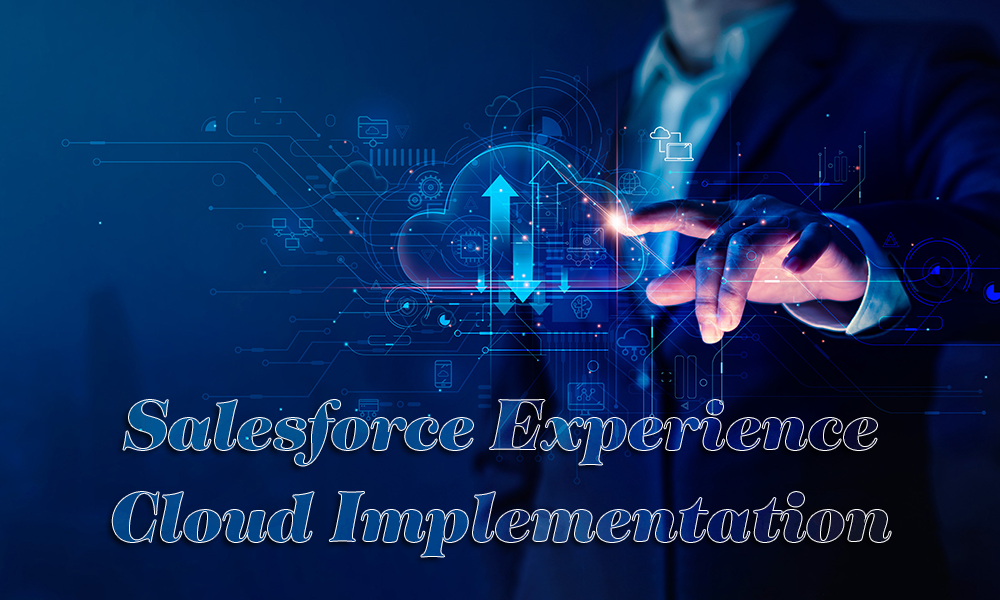Does your business need a solution that will enable you to stay connected with your customers and partners and keep them satisfied? If you are looking for a platform that can help you keep your customers and partners engaged & close to the brand, you have come to the right place. In this post, we will discuss the experience cloud, its features, benefits, and the step-by-step implementation process.
Let’s begin!!

What is Salesforce Experience Cloud?
In today’s digital age, customer experience plays a pivotal role in the success of any business. Organizations strive to create seamless and personalized experiences that keep their customers engaged and satisfied.
Salesforce, a leading customer relationship management (CRM) platform, understands the significance of customer experience and has introduced Salesforce Experience Cloud as a powerful solution to transform the way businesses engage with their customers.
Salesforce Experience Cloud, formerly known as Salesforce Community Cloud, is a dynamic platform that empowers organizations to build customized digital experiences for their customers, partners, and employees.
It serves as a central hub where users can access relevant information, collaborate, and interact with businesses on a whole new level. It also comprises of few top qualities and capabilities of other Salesforce clouds such as –
Community Cloud –Capabilities of creating online communities for customers, employees, and partners.
Marketing Cloud – Capabilities of executing digital marketing campaigns, including social media, email, etc.
Service Cloud – Capabilities to strengthen customer services and support include live chat, case management, and more.
Commerce Cloud – eCommerce capabilities to manage & operate online businesses, including product catalog management, shopping cart management, and many more.
Features that Make Experience Cloud Stand Apart from its Competitors
With its robust set of features and functionalities, Salesforce Experience Cloud revolutionizes the way organizations connect and collaborate with their stakeholders. Let’s explore some of its top features:
Customizable Portals
Salesforce Experience Cloud allows businesses to create fully customizable portals that align with their branding and user experience requirements. With drag-and-drop tools and pre-built templates, organizations can quickly design and tailor their portals to meet specific needs.
Personalized Experiences
Experience Cloud provides dynamic, personalized experiences by leveraging Salesforce’s powerful CRM capabilities. Businesses can deliver tailored content, recommendations, and offers based on user preferences, demographics, and behavior, enhancing engagement and satisfaction.
Community Collaboration
Salesforce Experience Cloud facilitates collaboration by providing discussion forums, chat functionalities, and knowledge bases. Users can connect, share insights, and collaborate on projects, fostering a sense of community and driving productivity.
Partner Relationship Management
With Experience Cloud, businesses can streamline partner interactions and improve channel effectiveness. It enables partners to access relevant resources, track leads, register deals, and collaborate seamlessly, resulting in stronger partner relationships and increased revenue.
Mobile-Optimized Experience
Salesforce Experience Cloud offers a mobile-responsive design, ensuring a seamless user experience across devices. Users can access the portal on their preferred mobile devices, enabling on-the-go collaboration and engagement.
Integration Capabilities
Experience Cloud integrates seamlessly with other Salesforce products and third-party systems, allowing organizations to leverage existing data and processes. This integration ensures a cohesive experience for users and enables efficient data management and automation.
Some more features include gamification & rewards, community management & analytics, improved engagement building, easy-to-access, and business integration.
Implementing Salesforce Experience Cloud requires expertise and strategic planning. Organizations can partner with experienced Salesforce consulting firms, like FEXLE Services, for a seamless and successful implementation.
These partners bring deep domain knowledge and technical expertise to ensure the best utilization of Salesforce Experience Cloud’s features and deliver a compelling digital experience for customers, partners, and employees.
Build an Unparalleled & Dynamic Digital Experience for Your Customers & Partners
With Salesforce’s experience in cloud implementation, businesses can build excellent digital experiences for a wide variety of use cases. A user can build –
- Partner Portal
- Mobile app
- Account portal
- Support site
- Storefronts
- Help centers
- Microsites
- Customer service hub
- Industry-specific solutions
With the Salesforce experience cloud, you are cultivating a single source of truth with respect to your customers and partners and get a clear picture of your business and all stakeholders.
Step by Step Guide for Salesforce Experience Cloud Implementation
Step 1 – Create Digital Experience for Stakeholders
- Find the digital experience set in the quick find box.
- Click on the setting option and enable digital experience.
- Put the domain name of your choice. Not changeable.
- click on save.
Step 2 – Create Communities
- Search & select “All Sites” in setup.
- Create a new digital experience.
- Select a suitable one from a pre-defined template as per requirements. You can select a customer service template for customer support.
- Click on Get Started and go to the next page.
- Choose a community name, and customize the URL with a unique value. Click on the Create button.
Step 3 – Activate Digital Experience
- Find All Communities from Setup.
- Move to your Workspaces.
- Click on Administration.
- Go to settings & click on the Activate community button.
Step 4 – Publish Experience
- Go to Setup. Click All Sites and to Builder.
- Click Publish.
And finally, your newly created community is all set for your end-users.
Things to Keep in Mind While Implementing Salesforce Experience Cloud
The following are given the best practices to follow for a successful implementation of the Experience Cloud –
Define Objectives and Requirements
Begin by clearly defining your objectives for implementing Salesforce Experience Cloud. Identify the specific use cases, target audience, and desired outcomes. Gather requirements from stakeholders to understand their needs and expectations.
Plan and Design the Portal
Develop a comprehensive plan for the portal’s architecture, design, and customization. Determine the portal’s structure, navigation, branding, and user interface. Map out the required functionality, such as user registration, content access, collaboration features, and integrations.
Configure and Customize
Leverage the Salesforce Experience Builder to configure and customize your portal. Use the drag-and-drop tools to create pages, components, and templates. Customize the branding, colors, fonts, and layouts to align with your organization’s visual identity.
User and Access Management
Define user roles, profiles, and permissions within Salesforce Experience Cloud. Determine who will have access to specific content, features, and functionality. Set up authentication and security measures to ensure data privacy and protect sensitive information.
Content and Data Management
Organize and structure your content within the portal. Create knowledge bases, discussion forums, FAQs, and other relevant resources. Configure search capabilities to help users easily find the information they need. Integrate with Salesforce CRM to leverage existing data and provide personalized experiences.
Collaboration and Engagement Features
Implement collaboration tools such as discussion boards, chat functionality, and social feeds to encourage user engagement and foster a sense of community. Enable users to connect, share insights, ask questions, and collaborate on projects within the portal.
Mobile Optimization
Ensure that your Salesforce Experience Cloud implementation is mobile-responsive. Test the portal’s usability and functionality across various mobile devices and screen sizes. Optimize the user experience for mobile users to enable seamless access and engagement on the go.
Training and User Adoption
Provide comprehensive training and resources to educate users on how to effectively use Salesforce Experience Cloud. Conduct workshops, webinars, or one-on-one sessions to familiarize users with the portal’s features and functionality. Encourage user adoption by highlighting the benefits and value of the portal.
Ongoing Monitoring and Optimization
Continuously monitor and analyze user engagement, portal usage, and feedback. Gather insights from analytics and user feedback to identify areas for improvement and optimization. Regularly update and enhance the portal to meet evolving user needs and industry trends.
Support and Maintenance
Establish a support system to address user inquiries, issues, and enhancements. Provide ongoing maintenance, bug fixes, and upgrades to ensure the portal’s smooth operation and optimal performance.
Conclusion
Salesforce experience Cloud is an essential platform for businesses that are looking for growth and strong customer relationships.
As a Salesforce implementation partner, FEXLE will walk the extra mile to reap the benefits of increased customer engagement for your business. We will offer a 360-degree solution to each business irrespective of its size and industry.
Strengthen your customer support with the power of personalization and get Salesforce experience cloud implementation services for your business today!








